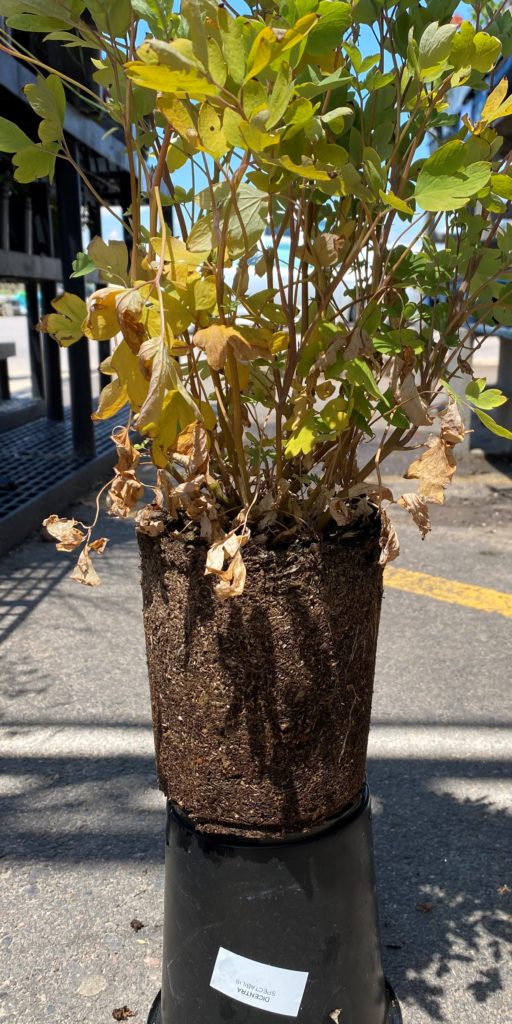
Providing a sustainable product
It’s no secret that growing plants in Colorado is not an easy feat! Our soil, wind, and variable temperatures make this a very temperamental climate to keep plants healthy and growing. It is our responsibility as nursery professionals to make sure that the products we’re growing, selling, and recommending are well-suited for the harsh Colorado climate. While a plant may look great sitting on the shelf; we need to ask the question “will it continue to look great once it’s planted in the landscape?”
By providing the right product, nurseries can build trust with their customers, decrease warranties, and increase customer satisfaction and retention. How can we do our due diligence to make sure that our customer continues to be satisfied with their purchase long after they’ve left the nursery? I have found that one of the biggest hurdles in plant viability is that so many plants sold into Colorado are “Shelf Pretty,” but are ultimately not “Landscape Strong.” The following factors play a large role in whether a plant is shelf pretty or truly landscape strong: Soil/Growing Media, Nutrient/Fertilizer applications, Plant Size, and Water Demands.
Growing Medium
“Soil-less” growing mediums seem to be the norm among large commercial growers. These are popular because they are light weight and often void of weed seeds and pathogens. These soil-less Peat-Lite mixes that we see so often are capable of growing a great looking plant but only as long as it’s being fed nutrients from fertilizers. These growing mediums themselves are nearly void of any nutrients. They allow plants to root quickly within the container, yet create fragile root systems. Under these conditions, the plant struggles to root into our tough native soils before winter sets in when it will ultimately freeze-dry. These soil-less mediums hold water like a sponge within the gaps of the medium instead of retaining water within the substrate itself. This causes the water to be wicked away to the surrounding soil. Combine that with our sunny, dry, cold winters, and any remaining moisture evaporates to leave the plant and its root system completely freeze-dried. Freeze-drying of plants both in the nursery and in the landscape creates losses for the nurseries and the need to warranty in the spring. Purchasing or growing plants in a heavier medium will create a more robust, hardy plant that will better survive winter kill, lessen warranties, and provide a stronger product for our Colorado market.

(Photo courtesy of Kathleen McGuar, CCNG, CGG)
Nutrient Source
While liquid fertilizers guarantee a quick finish and a full product for production growers, it’s not a sustainable approach for growing hardy plants that can hold up to Colorado’s environment. Liquid fed plants land at your nursery looking great, but quickly run out of nutrients, yellow out, and go downhill. Constantly having to liquid feed product on your shelves to keep it looking nice increases your costs and ultimately passes the viability problems on to your customer. Homeowners and landscape install/maintenance crews generally do not liquid feed their plants. Feeding a steady diet of liquid fertilizers creates pampered plants that are solely reliant on easily available nutrient sources and, as soon as that source is gone; the plant is going to quickly fade. Liquid fed plants are also less likely to bridge the gap and overcome the challenges of rooting into native soils. Granulated fertilizers, slow-release fertilizers, and organic matter, (such as compost) will eliminate a plant’s reliance on liquid fertilizers, and grow a stronger, more balanced plant that will stay healthier longer on your shelf and in the landscape.
Plant Size
Everyone wants a big showy plant, right? It’s not necessarily a good choice. An overgrown plant is often a liability to you and your customer during our hot, unforgiving summers. A large, overgrown plant requires more water and nutrients to keep it happy and healthy. Not all plants grow the same and, likewise, there is a sustainable size for every plant. We’ve all seen blocks of plants in containers that look full and lush but, as soon as you pull one out, it immediately flops over without the support of its neighbors. This creates its own problems. Once that plant is totally exposed without the shade and protection of its neighbors; it will to go into shock and immediately stall out, dry out, and die back. Unfortunately, the bigger the plant, the bigger the shock it may experience when it gets to your nursery, or the worse it will fare when planted by your customer in the landscape where it will receive less care. Smaller, more compact plants last longer on the shelf and handle the transition from pot to landscape much better than overgrown plants.
Water Needs
Here in Colorado, water is always a hot topic. Water usage and plant water needs all stem back to the previously discussed attributes. The larger your plant and the lighter your soil medium, the more water is needed to sustain the plant. This is another issue with soil-less mediums and overgrown plants – they require constant water. Because the soil drains so quickly and overgrown plants drink so much, nurseries are forced to water constantly, often further flushing out any nutrients that may be present. However, when that plant gets into the landscape, the homeowner or install crew will most likely face watering restrictions and not be able to meet the water requirements that the plant is used to in a nursery setting. This leads to transplant shock, heat stress, and slow deterioration due to insufficient water. A more compact plant in a heavier, water-retaining soil will transition better during and after planting into the more restrictive watering schedule that so many HOAs or municipalities enforce.
Your Best Bet The rough conditions Colorado throws at our plants play a huge role in whether a plant is landscape strong and going to survive. While those full, flushed plants may draw your attention, it is important to look beyond what we see on the shelf. Always keep in mind that every plant needs to be able to survive our tough environment. So, when growing or purchasing plant material, look for a compact plant that is appropriately sized, grown in a heavier soil-like medium, and don’t be afraid to ask your grower about their fertilization techniques and water regiments. Keep these things in mind and ask “will it be landscape strong?” when sourcing your material to ensure the most sustainable product for you and you customers.










